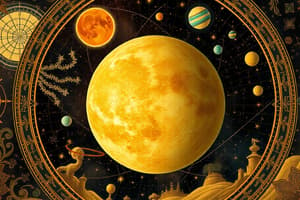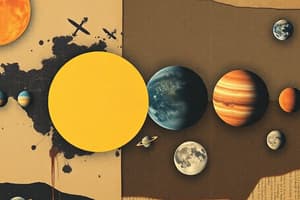Podcast
Questions and Answers
What primarily defines a planet's shape, according to the passage?
What primarily defines a planet's shape, according to the passage?
- The presence of an atmosphere
- Its gravitational pull (correct)
- Its proximity to the sun
- The composition of its core
How many solar systems are estimated to exist within the Milky Way Galaxy?
How many solar systems are estimated to exist within the Milky Way Galaxy?
- Millions
- 3,200 (correct)
- Nine
- An unknown, immeasurable amount
What distinguishes 'terrestrial' planets?
What distinguishes 'terrestrial' planets?
- An extremely hot surface temperature
- Solid, rocky surfaces and metallic cores (correct)
- Multiple moons and ring systems
- Gaseous composition and large size
Which celestial body was reclassified in 2006, changing the number of planets in our solar system?
Which celestial body was reclassified in 2006, changing the number of planets in our solar system?
What mnemonic helps remember the order of planets?
What mnemonic helps remember the order of planets?
Besides planets and moons, what other celestial bodies are found in solar systems?
Besides planets and moons, what other celestial bodies are found in solar systems?
What force clears a planet's orbital path?
What force clears a planet's orbital path?
What is an "atmosphere" as described in the text?
What is an "atmosphere" as described in the text?
What primarily distinguishes Jovian planets from terrestrial planets?
What primarily distinguishes Jovian planets from terrestrial planets?
What is the defining characteristic of a moon?
What is the defining characteristic of a moon?
Approximately how many moons does Jupiter have?
Approximately how many moons does Jupiter have?
What is the primary composition of asteroids?
What is the primary composition of asteroids?
What distinguishes a comet from an asteroid?
What distinguishes a comet from an asteroid?
What is the difference between a meteoroid, a meteor, and a meteorite?
What is the difference between a meteoroid, a meteor, and a meteorite?
What causes a meteor to heat up as it enters Earth's atmosphere?
What causes a meteor to heat up as it enters Earth's atmosphere?
Flashcards
Solar System
Solar System
A system consisting of a sun and celestial bodies orbiting it, including planets, moons, and asteroids.
Celestial Bodies
Celestial Bodies
Objects in space such as planets, moons, asteroids, comets, and more.
Planet
Planet
A celestial body orbiting the sun, shaped into a sphere by gravity, and clears its orbit of other debris.
Number of Planets
Number of Planets
Signup and view all the flashcards
Closest Planet to the Sun
Closest Planet to the Sun
Signup and view all the flashcards
Terrestrial Planets
Terrestrial Planets
Signup and view all the flashcards
Jovian Planets
Jovian Planets
Signup and view all the flashcards
Pluto's Status
Pluto's Status
Signup and view all the flashcards
Moons
Moons
Signup and view all the flashcards
Asteroids
Asteroids
Signup and view all the flashcards
Comets
Comets
Signup and view all the flashcards
Meteoroid
Meteoroid
Signup and view all the flashcards
Meteor
Meteor
Signup and view all the flashcards
Meteorite
Meteorite
Signup and view all the flashcards
Study Notes
Solar System Overview
- The solar system includes the sun, eight planets, and other celestial bodies like moons, asteroids, comets, meteoroids, dwarf planets, and meteorites.
- Multiple solar systems exist within the Milky Way galaxy, some with multiple suns and planets.
- There are approximately 3,200 known solar systems in the Milky Way.
Planet Definition
- To be considered a planet, a celestial body must:
- Orbit the sun.
- Have enough gravity to pull itself into a spherical shape.
- Have cleared its orbital path of other objects.
- Definitions of planets are still evolving.
Solar System Planets
- There are eight planets in our solar system after Pluto was reclassified as a dwarf planet in 2006.
- Planets are ordered from closest to farthest from the sun: Mercury, Venus, Earth, Mars, Jupiter, Saturn, Uranus, Neptune.
- A mnemonic device to help remember the order is "My Very Educated Mother Just Served Us Nachos."
- Mercury is closest to the sun.
Planet Types
- Terrestrial Planets: Solid surface, rocky composition, relatively small, have a metal core and atmosphere (e.g., Mercury, Venus, Earth, Mars).
- Jovian Planets: No solid surface, primarily gaseous, larger than terrestrial planets (e.g., Jupiter, Saturn, Uranus, Neptune).
Moons
- Moons orbit planets, not the sun.
- Earth has one large moon.
- Some planets, like Mercury and Venus, have no moons.
- Jupiter is thought to have 79 moons, with 53 confirmed by NASA.
Asteroids, Comets, and Meteoroids
- Asteroids: Larger than meteoroids, made of metal, rock, or both, considered minor planets (orbit the sun). Many congregate in the asteroid belt.
- Comets: Small, icy bodies of frozen gases, rocks, and cosmic dust that orbit the sun elliptically. Develop a tail as they approach the sun.
- There are 3,743 known comets in early 2022.
- Meteoroids: Small objects floating in space.
Meteorites, Meteors
- Meteoroids become meteors when they enter Earth's atmosphere and are heated by friction.
- Meteors frequently burn up completely in the atmosphere.
- Meteorites are the remnants of meteors that reach Earth's surface.
- Shooting stars are meteors appearing as streaks of light.
Studying That Suits You
Use AI to generate personalized quizzes and flashcards to suit your learning preferences.




